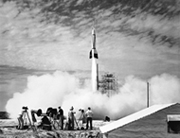
Cape Canaveral, Florida, launches its first rocket.
Cape Canaveral was just an obscure spit of land when a U.S. Air Force committee recommended it for missile testing in 1948. The cape was actually the committee’s second choice. A California site was rejected after Mexico refused to let rockets cross over Baja California. (That decision was probably influenced by a near miss when a wayward rocket from White Sands, New Mexico, crashed into a Juarez cemetery.)

The fact that the downrange trajectory of a rocket launched eastward was over the ocean was desirable. And Canaveral was closer than the California site to the equator, which made it easier to launch rockets. So, President Harry Truman inked legislation in 1949 establishing the Joint Long Range Proving Ground at Cape Canaveral.
The first rocket to lift off there was a Bumper V-2, modified from the World War II–era German V-2s that pounded London. The two-stage rocket—a V-2 booster topped by a WAC-Corporal second stage—was launched mainly to conduct atmospheric tests. A second Bumper went up three days later.
The Florida installation, which originally included four launchpads and a few buildings, expanded rapidly during the early 1950s. More land was acquired; Patrick Air Force Base was established nearby, and a dizzying array of military and NASA space projects soon followed.
Following President Kennedy’s assassination, former first lady Jacqueline Kennedy suggested to President Lyndon Johnson that renaming the space center for JFK would be a fitting memorial. LBJ went her one better, and Cape Canaveral itself was renamed Cape Kennedy. The new name held up until 1973, when the original name (which first appeared on a 1564 Spanish map) was restored, and the facility became the Kennedy Space Center. Which was all Jackie had ever asked for.—TL